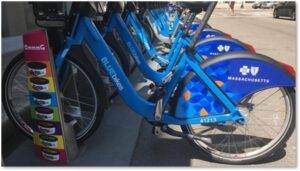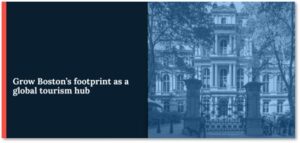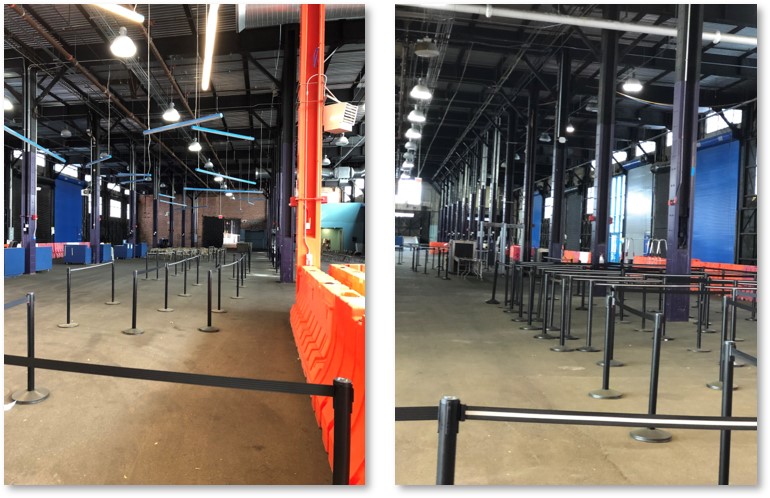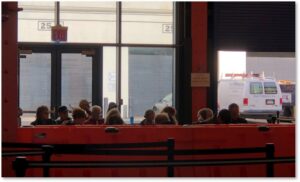Yesterday’s Boston Globe held an editorial on the need for an “urban mechanic” in downtown Boston as part of Mayor Wu’s plan for revitalizing the downtown. The paper’s editorial notes the importance of tourists and tourism for the city’s economy and mentions a number of ideas for improving it.
Tourist-Related Improvements
The report itself focuses on several tourist-related improvements: (1) an all-inclusive pass to the city’s attractions; (2) a marketing campaign to draw more people to the city; and (3) revitalization of the Faneuil Hall-Quincy Market area.
Well, count me in. I have been a professional tour guide in Boston for almost 10 years. I lead walking tours of different parts of the city, narrate Boston history from inside a tour bus filled with cruise ship passengers, and ride in limos for private tours. That has given me a pretty direct experience with what visitors to Boston need.
The report’s ideas are all good ones and Boston would be wise to implement them. But what tourists need goes beyond that. Once people get here—and stray outside of the Quincy Market area—they require other things as well.
Restrooms: Clean and Safe
I wrote a post in 2018 asking why there is Nowhere to Go in Boston. Tourists need clean and safe restrooms located in convenient places. Too often, the city provides few of these and the ones that exist get a lot of use. Cleanliness suffers.
The city has long ignored the biological needs of its visitors, preferring to shift the burden onto businesses. That has to change.
Parking for Tour Buses
Cruise ships dock at the Black Falcon Terminal and enter Boston through the Raymond Flynn Cruiseport. For those who have never gone out there, the facility is located over two miles from Faneuil Hall, and even further from downtown attractions.
Tour buses take people to those attractions but, once at their destination, those buses must park so people can get off. Bus parking is available only in a few places but, even then, it’s short term. I can talk to people in Copley Square for 15 minutes. It takes almost 10 minutes just to get them off the bus. The situations at Old Atlantic Avenue by the New England Aquarium and the Steriti Memorial Rink on Commercial Street are much worse. Bus parking spaces by Quincy Market are often filled up.
Frequently, the drivers can’t find a place to park because the allotted spaces have been taken up by other vehicles, from city maintenance trucks and police cruisers to cars. Enforcement is spotty: rigorous in some places and very lax in others. If the buses have to move and come back, they add to the city’s traffic and air pollution.
An Improved Cruiseport
Speaking of the Cruiseport, let’s just say it doesn’t provide a welcoming experience. The Black Falcon Terminal is basically a warehouse into which MassPort puts some folding metal chairs. Amenities include:
- Bathrooms (may or may not have soap)
- A few scattered vending machines
- A very small “Welcome to Boston” kiosk that is usually unattended
- Electric lights
It lacks any heat, which makes the place miserable on cold, windy, or rainy days. Passengers sit on their uncomfortable folding chairs and shiver while they wait to board their bus. The pier workers who spend the entire day moving tourists in and out of the Cruiseport don’t even have a place where they can warm up.
A cruise ship in port may put out a coffee or ice water stand for their passengers. If they don’t, only vending machine “refreshments” are available. The doors of the cruise port look like those of a commercial garage.
Cold and Annoyed Tourists
Cruise ship passengers tend to be elderly and many have mobility issues but they like to travel. These folks have been to other cruise ports in US cities and overseas. Boston’s Raymond Flynn Cruiseport does not impress them. They get cold on bad days and annoyed at the facility’s minimalist atmosphere almost all the time.
MassPort ensures excellent security with guards and State Police officers who check ship IDs and Transportation Worker Identification Cards. But MassPort makes no effort to provide a welcoming environment, It doesn’t give tourists a comfortable place to sit, good maps of the city, or guidance on what to visit and where to shop.
I have had passengers ask me about the nearest Walgreen’s, public transportation (the Silver Line buses go only to South Station), shopping, etc. The Cruiseport’s vast space offers lots of opportunity for a nicely appointed lounge, a Dunkin outlet, souvenir vendors, a place to buy some aspirin or toothpaste, etc. Those things could bring in revenue, as well.
Enforce the Bicycle Laws
While it’s great to have bike lanes and Blue Bikes, you have to get people to follow the rules and ride responsibly. In the past two weeks, I saw a young man biking the wrong way on Newbury Street, winding through heavy traffic and around cars in the middle of the road. Everyone on the bus commented on his stupidity.
 Another time, I stepped off a bus on St. James Street near Trinity Church only to encounter a young couple on Blue Bikes flying down the sidewalk. The man swerved to miss me but the woman shouted “Watch out!” as she hurtled past. When you are trying to help people who are using canes, walkers, Rollators and other devices for the mobility impaired—people for whom that last step off the bus is a problem—it doesn’t help to have bicyclists on the sidewalks acting as if they have the right of way.
Another time, I stepped off a bus on St. James Street near Trinity Church only to encounter a young couple on Blue Bikes flying down the sidewalk. The man swerved to miss me but the woman shouted “Watch out!” as she hurtled past. When you are trying to help people who are using canes, walkers, Rollators and other devices for the mobility impaired—people for whom that last step off the bus is a problem—it doesn’t help to have bicyclists on the sidewalks acting as if they have the right of way.
An Army of Tour Guides
There are many other opportunities to make Boston’s visitors feel welcome and cared for, as well as to make it easy for them to visit our attractions. The city has a whole army of tour guides working or volunteering for a variety of organizations. Just ask us. We’ll tell you.
Winter is upon us and the 2022 tourist season has effectively ended. Boston has at least six months to implement the report’s suggestions before next year’s tourist season hits. The city could also consider other ideas. Let’s get to work and make at least some improvements before the tourists return next year.





